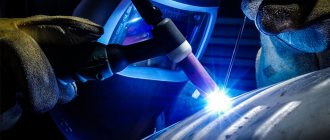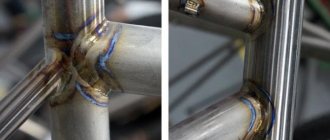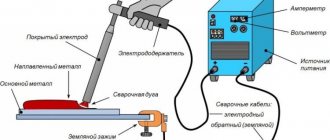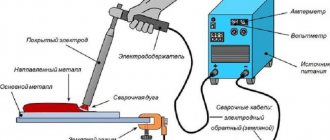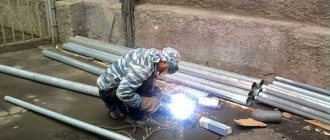The remarkable physical and chemical properties of tungsten are widely used in industrial production. Tungsten is most widely used in the chemical industry and electrical engineering. For many decades, we did not know any other type of lighting other than incandescent light bulbs, the spiral of which was made of tungsten wire. This metal was chosen due to its ability to operate at high temperatures.
1 / 1
The remarkable physical and chemical properties of tungsten are widely used in industrial production. Tungsten is most widely used in the chemical industry and electrical engineering. For many decades, we did not know any other type of lighting other than incandescent light bulbs, the spiral of which was made of tungsten wire. This metal was chosen due to its ability to operate at high temperatures.
Know what material is to be welded
Regardless of the welding method, special attention must be paid to the brand and characteristics of the parts being welded. It is also important to know the conditions under which the weld and the structure as a whole will be used.
First of all, this factor influences the choice of the right brand of welding consumables that are best suited for given conditions.
For example, if high demands are placed on the structural homogeneity of the weld with the base metal, it is necessary to select welding materials that fully satisfy all requirements.
Before you start welding aluminum or welding stainless steel, you need to know the grade of metal in order to select the right welding materials. because Depending on the chemical composition, different alloys exhibit a tendency to increased deformation and crack formation. Some metals and their alloys require preheating or heat treatment, which affects the selection of the correct welding material.
When welding products made of steel 20 with a thickness of up to 100 mm, no preheating is required, and for steel 12Kh1MF, starting with a thickness of 6 mm, preheating of products to a minimum temperature of 200°C and subsequent heat treatment of the weld are required.
Before TIG welding aluminum alloys with a non-consumable electrode, you always need to know what grade of aluminum is to be welded in order to choose the right welding material. Typically, manufacturers indicate on the packaging what grades of alloys these welding materials are intended for.
How to cook aluminum correctly
The welding process begins with preliminary preparation of the working edges. The main goal is surface cleaning, which is carried out in several stages:
- workpieces must be thoroughly cleaned using chemical compounds;
- after drying, the surface must be degreased with any solvent: acetone, aviation gasoline, white spirit or other liquid;
- if products with a thickness of more than 4 mm are subject to welding, then the edges should be cut;
- the final procedure is to clean the edges from the oxide layer; For this, the following tools are used: a file, sandpaper, a brush with steel bristles.
Select the correct tungsten electrode
An important factor in argon arc welding is a properly selected tungsten electrode that conducts the welding current to the arc. The right choice is influenced by two factors:
- thickness of welded metal
- welding current value
Depending on the manufacturing standard, electrodes are supplied in various diameters, usually from 1 to 4 mm, and in lengths of 150 or 175 mm.
According to ISO 6848 “Arc welding and cutting. Tungsten welding electrodes, non-consumable. Classification" electrodes are supplied in the lengths and diameters shown in the tables below.
Tungsten Electrode Standard Diameter and Tolerance (ISO 6848)
| Diameter, mm | Tolerance, mm |
| 0,25 | ±0,02 |
| 0,30 | |
| 0,50 | ±0,05 |
| 1,0 | |
| 1,5 | |
| 1,6 | |
| 2,0 | |
| 2,4 | ±0,1 |
| 2,5 | |
| 3,0 | |
| 3,2 | |
| 4,0 | |
| 4,8 | |
| 5,0 | |
| 6,3 | |
| 6,4 | |
| 8,0 | |
| 10,0 |
Tungsten Electrode Length and Tolerance (ISO 6848)
| Length, mm | Tolerance, mm |
| 50 | ±1,5 |
| 75 | +2,5 -1,0 |
| 150 | +4 -1 |
| 175 | +6 -1 |
| 300 | +8 -1 |
| 450 | +8 -1 |
| 600 | +13 -1 |
You can get acquainted with the range of electrodes according to GOST by clicking on the link GOST 23949.
The electrodes contain pure tungsten and tungsten with activating additives (rare earth elements and their oxides):
- lanthanum oxide
- yttrium oxide
- thorium dioxide
- tantalum
- cerium
To avoid confusion, depending on the chemical composition, tungsten electrodes are divided according to the color of the marking, which is applied to one of the ends. The requirement for color marking is set out in ISO 6848 and GOST 24949.
Color marking of tungsten electrodes according to ISO 6848
| Classification symbols | Chemical composition | Color code, RGB color value | |||
| Adding Oxide | Impurities, % | Tungsten,% | |||
| Main oxide | % | ||||
| W.P. | No | — | 0.5 maximum | 99.5 minimum | Green #008000 |
| WCe 20 | CeO2 | 1,8 — 2,2 | 0.5 maximum | rest | Gray #808080 |
| WLa 10 | La2O3 | 0,8 — 1,2 | 0.5 maximum | rest | Black #000000 |
| WLa 15 | La2O3 | 1,3 — 1,7 | 0.5 maximum | rest | Gold #FFD700 |
| WLa 20 | La2O3 | 1,8 — 2,2 | 0.5 maximum | rest | Blue #0000FF |
| WTh 10 | ThO2 | 0,8 — 1,2 | 0.5 maximum | rest | Yellow #FFFF00 |
| WTh 20 | ThO2 | 1,7 — 2,2 | 0.5 maximum | rest | Red #FF0000 |
| WTh Z0 | ThO2 | 2,8 — 3,2 | 0.5 maximum | rest | Purple #EE82EE |
| WZr 3 | ZrO2 | 0,15 — 0,50 | 0.5 maximum | rest | Brown #A52A2A |
| WZr 8 | ZrO2 | 0,7 — 0,9 | 0.5 maximum | rest | White #FFFFFF |
In addition to the requirements of international standards, GOST 24949 also requires the classification of tungsten electrodes by color.
Marking of tungsten electrodes by color depending on the chemical composition according to GOST 23949
| Brand | Mass fraction, % | Color | |||||
| Tungsten, no less | Additives | Impurities, no more | |||||
| Lanthanum oxide | Yttrium oxide | Thorium dioxide | Tantalum | Aluminum, iron, nickel, silicon, calcium, molybdenum (total) | |||
| EHF | 99,92 | — | — | — | — | 0,08 | Not marked |
| EVL | 99,95 | 1,1 — 1,4 | — | — | — | 0,05 | Black |
| EVI - 1 | 99,89 | — | 1,5 — 2,3 | — | — | 0,11 | Blue |
| EVI - 2 | 99,95 | — | 2,0 — 3,0 | — | 0,01 | 0,05 | Violet |
| EVI - 3 | 99,95 | — | 2,5 — 3,5 | — | 0,01 | 0,05 | Green |
| EVT - 15 | 99,91 | — | — | 1,5 — 2,0 | — | 0,09 | Red |
The table below provides recommendations for choosing the type of current depending on the type of material being welded.
Recommendations for choosing the type of current depending on the type of metal being welded
| Type of metal or alloy to be welded | D.C | Alternating current | |
| Straight polarity (- at the electrode) | Reverse polarity (+ on electrode) | ||
| Aluminum and its alloys less than 2.5 mm thick | allowed | allowed | most suitable |
| Aluminum and its alloys with a thickness of more than 2.5 mm | allowed | Not recommended | most suitable |
| Magnesium and its alloys | Not recommended | allowed | most suitable |
| Unalloyed and low alloy steels | most suitable | Not recommended | Not recommended |
| Stainless steel | most suitable | Not recommended | Not recommended |
| Copper | most suitable | Not recommended | Not recommended |
| Bronze | most suitable | Not recommended | allowed |
| Aluminum bronze | allowed | Not recommended | most suitable |
| Silicon (silicon) bronze | most suitable | Not recommended | Not recommended |
| Nickel and its alloys | most suitable | Not recommended | allowed |
| Titanium and its alloys | most suitable | Not recommended | allowed |
Each option has characteristics suitable for use in certain situations or for RAD welding of metals:
- aluminum and its alloys are welded with alternating current using a pure tungsten electrode;
- electrodes alloyed with cerium are universal and therefore they are used practically for argon-arc welding of all types of metals, and with lanthanum or thorium they are used for welding stainless steel, as well as copper and titanium, and their alloys;
- Thoriated electrodes provide an advantage due to increased electron release density. It must be taken into account that they have a low level of radioactivity.
Sequencing
Before you start TIG welding, the joints must be cleaned of grease, rust, etc. The metal must be perfectly clean, otherwise everything will remain in the weld, which will affect its quality.
Most steels are welded with direct current. Aluminum, magnesium, copper alloys with a high aluminum content are welded with alternating current .
The current strength is selected according to the tables, depending on the type of material, its dimensions and the thickness of the welding rod. If you select too high a current during TIG welding, the rod will melt. At low current the arc is unstable.
Recommended arc length is 1.5-3 mm. Increasing the arc length leads to an increase in the width of the seam and a decrease in the penetration depth.
When welding butts, the welding needle should extend from the nozzle by 3-5 mm, with corner welding by 5-8 mm.
Welding with a non-consumable electrode begins with the start of inert gas. The welding process ends by turning off the argon 10-15 s after the arc goes out. This is necessary so that the crystallization process occurs without air access.
For very important connections, a non-contact arc ignition method is used. Available in industrial equipment. Used for welding corrosion-resistant steels. This prevents tungsten from getting into the seam. For less critical connections, a device with a contact arc ignition method is used. It is usually found in domestic installations.
For TIG welding, it is enough to move the torch along the joint without oscillating movements, as in conventional electric arc welding. This results in a narrow seam and increases the welding speed.
When using filler wire, it is necessary to ensure that the melted end is under a stream of inert gas. The weld pool should have an elongated shape, not round.
Correctly sharpen the tungsten electrode
Sharpening a tungsten electrode, more precisely the method and angle of sharpening, has a significant impact on the shape of the arc and its behavior and, as a consequence, on the shape of the weld and the service life of the non-consumable electrode.
For sharpening, it is necessary to use wheels with fine abrasive grains (the ideal option is a diamond wheel). It is advisable to use grinding wheels with a grain size of 40 or less (the size of the abrasive parts is less than 400 microns), since in this case the marks from the abrasive on the surface will be less deep and less precious tungsten will be ground off during the sharpening process. Deep grooves from the abrasive cause energy loss and unstable arc behavior. It is advisable not to work with other materials on the abrasive wheel where the cleaning is carried out. their particles can be deposited on the surface of the electrode.
Sharpening of a tungsten electrode must be done in the longitudinal (along the axis of the electrode), and not in the transverse direction.
Since tungsten electrodes during the manufacturing process have a grain structure that is located along the axis and sharpening in the transverse direction is grinding across the grain. But this is not as significant as the fact that electrons flow with high density along the surface of the electrode and, if the grooves from sharpening are located across it, it is more difficult for electrons to overcome them. Since the arc looks for places with the least resistance, it may not occur at the end of the tungsten electrode, but in the grooves from grinding and will rotate around the pointed end, which in turn causes overheating of the electrode and its rapid wear.
If the abrasive marks are located lengthwise, electrons flow evenly to the pointed end of the electrode with less resistance. In this case, the arc ignites at the end, is more stable and heats up the tungsten electrode less, which increases its service life.
During the sharpening process, make sure that the metal does not overheat. A sign of overheating is a change in the color of the surface and indicates that oxides have formed on the surface, which have greater resistance than tungsten and will prevent the arc from igniting.
The sharpening angle of the tungsten electrode plays a major role when welding with argon.
The blunter the sharpening angle >30°:
- harder arc ignition;
- narrower weld seam;
- more welding current is required;
- increasing the possibility of arc wandering;
- increasing the depth of metal penetration;
- longer service life of the tungsten electrode.
The sharper the sharpening angle <30°:
- easier arc ignition;
- wider weld seam;
- less welding current is required;
- reducing the possibility of arc wandering;
- reducing the depth of metal penetration;
- shorter service life of a tungsten electrode.
During the AC argon welding process, a significant amount of heat is generated at the end of the non-consumable electrode, which melts the tungsten, so it is necessary to make a slight blunting, which will allow the formation of a ball of molten tungsten at the end.
The tungsten electrode sharpening machine allows for perfect sharpening.
Welding aluminum at home: is it possible?
The need for aluminum welding can arise not only in industrial and production conditions, but also in everyday life. Some of the above methods for welding aluminum are successfully used at home:
- MMA technology, which involves the use of an inverter/transformer and consumable electrodes with coating;
- aluminum gas welding;
- DC MIG technology (semi-automatic);
- argon welding (AC TIG).
Each of these methods has its own characteristics, discussed earlier. However, performing household welding requires special attention. Therefore, we recommend that you familiarize yourself with the full list of nuances that arise when welding aluminum at home. By strictly following the instructions and advice, each performer will be able to efficiently connect aluminum products and structures.
Keep clean
Surface cleanliness is an important indicator for every welding process, but it is especially important for argon welding. Surface contamination can lead to the formation of pores and, therefore, require additional labor to correct them. This is especially important when TIG welding expensive metals such as titanium, aluminum and copper.
Before starting the process, the surface must be cleaned with a clean, dry and soft cloth using cleaning and degreasers to remove oils, grease and dirt. For titanium and its alloys, the fabric must additionally be lint-free and you must work with nitrile gloves that are resistant to oils and grease. When choosing a cleaning agent, pay attention to the fact that it does not contain chlorine. it can lead to health problems.
Due to the high temperature of the welding arc, chlorine evaporates and enters the welder's lungs.
Proper handling of the filler material is also important. Keep the rods (or pieces cut from the wire spool) clean, dry and sealed in a container. To prevent oxidation, it is necessary to maintain humidity and ambient temperature in storage areas in accordance with the recommendations of the manufacturer of these welding materials. Proper storage of basic materials is an important factor. Cross-contamination with particles of another material lying nearby or during stripping in close proximity to the TIG welding site can cause the formation of defects in the weld. To prevent contamination, it is necessary to use special abrasive materials and brushes designed for this type of metal. It must be borne in mind that titanium and magnesium abrasive dust is flammable and can have a detrimental effect on the weldability of other metals. Abrasives for these metals should be stored away from open sources of fire and separately from other materials.
In the process of performing all work related to welding stainless steel, it is necessary to use equipment and tools designed exclusively for this group of steels. Stainless steels must be protected from possible contact or contamination with lead, zinc, copper and its alloys, as well as unalloyed and low-alloy steels. More detailed information about the general requirements for welding stainless steel can be found in the video.
WY-20, dark blue
They are used in welding molybdenum, tantalum, copper, bronze, niobium, nickel, titanium. Universal by type of current (AC/DC).
The composition includes the addition of 2% cerium oxide, a non-radioactive element, which is safer for the welder to work with. Cerium facilitates easy initial start of the arc and allows increasing the welding current without harm to the equipment. The electrodes hold the arc perfectly at low currents when welding thin sheet steel. The most common application is orbital pipe welding.
Use welding fixtures that prevent the formation of deformations
Correct fixation of the parts being welded is an important requirement not only when welding with a tungsten electrode and helps to avoid many problems, including deformation. The thinner the parts to be welded, the more important it is to select suitable assembly and welding fixtures.
Clamp parts in several places to prevent linear deformation and ensure that gaps and angles are maintained using magnetic squares, corner clamps, welding pliers and other tools.
It is necessary to have patience and time for the correct assembly and fixation of parts with complex configurations. In this case, the “third hand” device has proven itself well, which helps to securely hold the parts after assembly and during the welding process. The third arm comes in many different designs and shapes, but is usually a heavy object that is placed or supported on the part and holds it in place for welding.
You can use special devices that help hold your hand during the welding process. Using hand and elbow supports helps maintain stability and reduces fatigue.
The preparation process may seem labor intensive, and in some cases take longer than the welding itself, but it is very important for producing a quality welded structure.
Use gas lens
High-quality gas protection has a direct effect on the weld metal. Using a TIG torch gas lens, which changes the gas flow pattern from the nozzle (turbulent to laminar) to improve shielding gas coverage of the weld metal, is one way to ensure the best quality weld.
Gas burner consumables include:
- ceramic cup
- collet
- cap
The gas lens replaces the collet body that is standard on a TIG torch. A standard collet usually has 4 holes for gas distribution, and the gas lens is a fine mesh. The flow of shielding gas passing through the gas lens is evenly distributed around the tungsten electrode, the welding arc and the weld pool, like an aerator on a faucet that cuts the flow of water into many small ones.
The gas lens provides much better protection of the molten metal of the weld pool, which is very important when argon arc welding of metals such as stainless steel and titanium. The gas lens also provides advantages when welding steel and aluminum. The use of torches with gas lenses is mandatory when there is a need to increase the level of protection of the weld pool or for welding in difficult-to-stop places that require a large tungsten electrode reach. It is necessary to take into account the fact that torches with gas lenses require the use of ceramic cups of a much larger diameter than with a standard collet.
The essence of the welding process with TIG equipment
If you are already familiar with types of welding such as MMA and MIG-MAG, then you probably know that the former uses an electrode as the main consumable material, and the latter uses a moving wire. TIG machines also use an electrode, but this time it is made of tungsten, a material that is refractory.
Protection against oxidation is provided by argon gas, which is why the process is often called argon arc welding. The English abbreviation TIG means Tungsten (tungsten) Inert (inert) Gas (gas), which affects the most important elements in the work.
Why is there a filler rod here? It is fed manually to form the seam. Under the action of an arc, the metal melts while in a protected gas environment and creates a high-quality connection.
In this article we will not focus on how the device itself is selected. For this purpose, a separate material has been created that will help you understand how to choose an argon arc machine for TIG welding.
Pre-weld the sample
To ensure that all preparatory operations are done correctly, if possible, it is necessary to weld the test sample with argon under identical conditions. The more critical the product is and the more expensive the material being welded, the more important it is to TIG weld the test sample. Taking the time to do this at the beginning can avoid many problems down the road, especially for unique parts or critical welds. The use of identical welding consumables will help to understand the impact of changing modes on the behavior of the welding consumables and base metal during the welding process.
Welding the sample is an extra step in preparation that will save a lot of time later in the production process.

